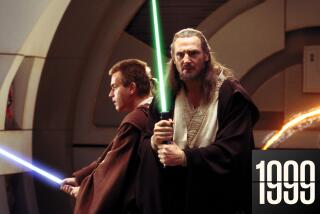Long ago and far away: ‘Star Wars’ vets reminisce
The fourth edition of “Great to Be Nominated,” the Academy of Motion Picture Arts and Sciences’ screening series honoring the film from each awards year that received the most nominations without winning best picture, blasts off Monday at the Samuel Goldwyn Theater with the 30th-anniversary screening of “Star Wars.”
Besides receiving a special achievement Oscar for Ben Burtt Jr.’s creation of the alien, robot and creature voices, George Lucas’ sci-fi blockbuster was nominated for 10 awards but lost the best picture Oscar to Woody Allen’s romantic comedy “Annie Hall.”
“Star Wars,” the second-highest-grossing film in the U.S. behind “Titanic,” won Academy Awards for art direction, costume design, film editing, music, sound and visual effects.
The sold-out screening will feature a post-movie discussion with Lucas as well as editor Richard Chew, visual effects wizards John Dykstra, Richard Edlund and Robert Blalack and art director Leslie Dilley.
Recently Chew, Edlund and Dilley reminisced about the film that spawned two sequels, three-prequels and changed the way movies are made.
Leslie Dilley on casting R2D2: “When we first started there were six of us,” he says, “George Lucas, producer Gary Kurtz, John Barry, myself, Roger Christian and a construction guy. Norman [Reynolds] wasn’t available, but he was going to join us. It wasn’t like you could go to the local prop house and pull out everything you wanted. It had to developed.
“One of my jobs was to develop R2D2. I had [concept artist] Ralph McQuarrie’s illustrations [of the robot] so I knew exactly what he looked like. The problem was we had to get someone inside it. We auditioned for little people. In fact, one of them was Deep Roy. He was perfectly formed, but he wasn’t strong enough to give the robot a life.
“So I eventually I ended up with Kenny Baker, who was small with upper-body strength. Kenny didn’t want to do this job. He and his buddy were on a talent show on TV. He and his buddy were a drummer and trumpeter, I think. They were getting close to the top prize. I had to go around to his house and persuade him.”
Dilley shared the art direction Oscar with his mentor John Barry, Norman Reynolds and set director Roger Christian.
Richard Chew on “low-budget” tricks: “It wasn’t like anything I had ever done before because there were so many missing pieces, not just visually but also the sound. It was a low-budget picture when you think of it. We had a short amount of time and didn’t have a lot of resources.
“One of the first sequences assigned to me was the gun-port sequence. This is where the princess and Luke jump onto Han Solo’s spaceship to escape the Death Star. They are each in their gun ports shooting away at the fighters who are chasing them. The only thing that George had at the time for me to cut with were these shots of Harrison Ford and Mark Hamill whipping around in their seats [in front of a blue screen] and shouting dialogue to each other.
“I said, ‘What’s going on here?’ And George showed me black-and-white footage he had put together from World War II dogfights. That is how he designed that sequence. He just said put together something that has a lot of action. Basically, all I did was put together these shots where these guys are whipping around in their seats. I would then trust that Industrial Light & Magic ... would design the models that would fit into the blue screen shots.
“One of the things that George was upset about was R2D2 wasn’t working well mechanically on the set. The movement was pretty short because it kept breaking down. The way it was shot mechanically, it couldn’t move that quickly, so you might get just one rotation of the head from right to fit. But just by using a cheap analog device in film printing, we would reverse the print [of his head moving] back and forth a couple of times ... so it would allow us to swivel the head of R2D2. It’s not human movement, so you could skip-frame it too, so you could speed up the pivoting [of the head]. When we added the voices later, it would cover over the jump cuts.”
Chew edited the film with Marcia Lucas and Paul Hirsch.
Richard Edlund on the early days of Industrial Light & Magic:
“Visual effects had been kind of quiet for about 20 years. I did go and consult with old masters, but it was a matter of having to invent ourselves. I walked into an empty room [in Van Nuys]. I had a card table and a phone on it. We built Industrial Light & Magic from scratch.
“The movie had a release date set before we start shooting, and we had about two years to work on it. It was nine months before we were able to shoot anything. We were building the system for nine months.
“We used very small miniatures. If we had used larger miniatures, we might not have finished the movie.
“We had thousands of elements to keep track of. Everybody had some great talent, and the others would go to that person if they could do something they couldn’t do. We were all leaning on each other. The coffee pot was always where information was traded and kept up to the moment.
“All the [effects] elements were shot separately and rephotographed with an optical printer, which is this huge mechanism that has two projectors and a lamp house. It was so difficult to do all of this stuff.”
Edlund was first cameraman, miniature and optical effects unit, and one of the founders of ILM.
More to Read
Only good movies
Get the Indie Focus newsletter, Mark Olsen's weekly guide to the world of cinema.
You may occasionally receive promotional content from the Los Angeles Times.











